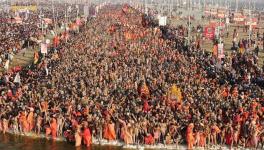#MahaDrought: Struggle for Water, Struggle for Life
[Maharashtra is facing one of the most severe droughts since 1972, with the state government declaring drought in 180 tehsils out of 350. Entire Marathwada (spread across Southern and Eastern Maharashtra) region is in dire condition now. This is part 11 of the series of ground reports by Newsclick.]
On December 20, 2018, Sunita Vijay Hatkar was filling her bucket, as she sat on the side of a wall bordering a well. A water tanker was also being filled at the well at the same time. Sunita was trying to get water from the very tap that was filling the tanker. Suddenly, the tanker flipped over to its left, and ended up crushing Sunita, who died on the spot. She is survived by her two sons and husband.
This bizarre accident happened as Hatkar was trying to fetch some drinking water for her family in the drought-hit Marathwada region of Maharashtra.
“We lost her for literally no reason. Water has become amrut (immortality potion) here. Everyone is struggling for it,” said Sunita’s husband Vijay. Her family lives in Joshiwadi basti of Nimkheda village, Phulambri tehsil of Aurangabad.
Situation is similarly grave in the entire region now. In Asola village of Dharur tehsil, tanker comes once in two days. So, villagers have come up with a token system, and every household gets water as per their token number. One person is appointed to take charge of this system. He sits near the well for hours and distributes tokens. “We give Rs 5 to the person per day. Because he is sitting there for the villagers without going to work. If we do not follow the system, there will be a chaos here,” said Rahibai Vasant Chole of Asola village.
c As per information available with the Aurangabad Divisional Office, as of Saturday, February 2, 2019, there were 1,539 tankers providing water to 25,39,095 people every day. Aurangabad district tops the list with 756 tankers, Beed is second with 440 tankers, Jalana with 252, Osmanabad with 45, Nanded with 28, Hingoli with 13, Parbhani with three and Latur with two tankers.
“There are many villages which are demanding tankers, but the state government is lagging in approving their proposals. Because Bharatiya Janata Party had assured tanker-free Maharashtra during 2014 assembly elections. This is the election year, and if such a high number of tankers becomes talking point, then the BJP will have nowhere to go,” alleged Dhananjay Munde, opposition leader of the state’s legislative council. Politics apart, the reality of the scarcity of drinking water is of grave concern.
“We keep fighting over water. It is obvious. Every villager wants more water. There is always a tension in the village when the water tanker arrives,” said Ashwini Machchhindra Dhas of Jamgaon village, Ashti tehsil, Beed.
The crisis is worse in the bastis of the nomadic tribes. The Banjara community has many tande (settlements) in almost all the districts of Marathwada. In the Lakshman Naik tanda of Aundha tehsil in Hingoli, women walk for 8 km per day to bring 60 litre of water. Parubai Rathod of this tanda is 55 years old. “I take four hours per day to fill water at my house. There are six members in my family. Four grandchildren, I, and my husband. So, I don’t have any other option than to walk from 6 to 10 in the morning for water,” she said. Her son and daughter-in-law have gone to the adjoining district Parbhani for sugarcane cutting work. This is the only income source for the family.
In Beed, Dharur’s Aaicha tanda village is having electric borewell, but the electricity supply is erratic. Kausabai Aade is a 58 years old lady of the Banjara community. She is staying alone at her house, as all the other members have gone for sugarcane cutting in Karnataka. She is getting water using an electric bore well. “But many times, the neighbours have to give water to me, as light (electricity) goes off. I can’t walk down on hilly slope for two km, and come back with two buckets of water. I don’t have that energy now. We used to do it when we were young,” said Kausabai.
Marathwada’s drinking water scarcity was national news when Maharashtra government had to take water by a train to Latur in 2016. “It is more serious than 2016. All reservoirs of Marathwada are drying up fast. That too at the start of March. Summer will last for four months. This drought will be one of the worst ever for drinking water issue,” said Pradeep Purandare, renowned water expert of Maharashtra.
Back in Nimkheda village, Sunita’s mother is crying. She lost her daughter, but the struggle for water still prevails. “We need to walk for 3 km for water. Tanker comes just once in three days. Sunita died, we suffered. But water is still far away from us,” she said. Actually, getting drinking water is no less than war in large part of Marathwada.
Also read:
#MahaDrought: Cattle Ban Ideologically Motivated, Harmful for Rural Economy, Say Farmers
Get the latest reports & analysis with people's perspective on Protests, movements & deep analytical videos, discussions of the current affairs in your Telegram app. Subscribe to NewsClick's Telegram channel & get Real-Time updates on stories, as they get published on our website.
























